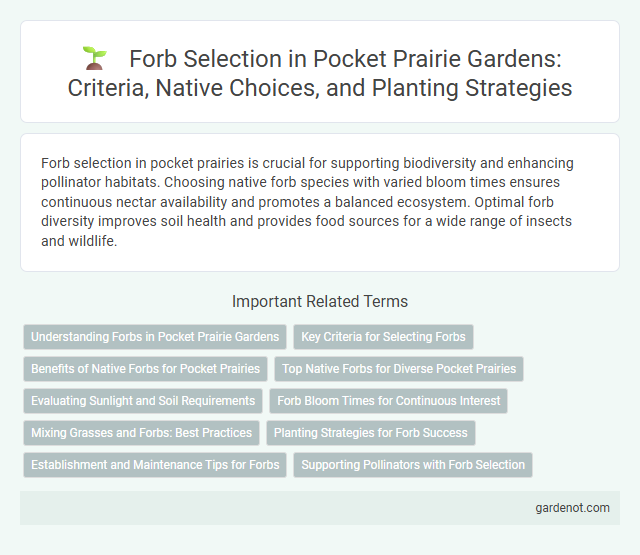Forb selection in pocket prairies is crucial for supporting biodiversity and enhancing pollinator habitats. Choosing native forb species with varied bloom times ensures continuous nectar availability and promotes a balanced ecosystem. Optimal forb diversity improves soil health and provides food sources for a wide range of insects and wildlife.
Understanding Forbs in Pocket Prairie Gardens
Forbs in pocket prairie gardens play a crucial role in enhancing biodiversity and supporting pollinator populations by providing essential nectar and pollen sources. Selecting native forb species adapted to local soil and climate conditions improves plant health and resilience, contributing to a balanced ecosystem. Understanding the growth habits and flowering periods of these forbs ensures continuous habitat availability for insects and wildlife throughout the growing season.
Key Criteria for Selecting Forbs
Key criteria for selecting forbs in a pocket prairie include native species adaptation, pollinator attractiveness, and bloom period diversity. Selecting native forbs ensures ecological compatibility and supports local wildlife, especially bees and butterflies. Including forbs with staggered bloom times maximizes floral resources throughout the growing season, promoting continuous habitat value.
Benefits of Native Forbs for Pocket Prairies
Native forbs in pocket prairies enhance biodiversity by providing essential nectar and pollen sources for pollinators such as bees and butterflies. Their deep root systems improve soil structure and water infiltration, promoting ecosystem resilience and carbon sequestration. Selecting regionally adapted native forbs supports local wildlife habitats and maintains genetic diversity crucial for sustaining prairie ecosystems.
Top Native Forbs for Diverse Pocket Prairies
Top native forbs for diverse pocket prairies include Echinacea purpurea (purple coneflower), Asclepias tuberosa (butterfly milkweed), and Rudbeckia hirta (black-eyed Susan), which provide essential nectar sources for pollinators. Selecting a variety of native forbs with different bloom times enhances habitat complexity and supports a broad spectrum of wildlife throughout the growing season. Incorporating species such as Coreopsis lanceolata and Monarda fistulosa ensures resilience and biodiversity in pocket prairie ecosystems.
Evaluating Sunlight and Soil Requirements
Selecting forbs for a pocket prairie involves assessing sunlight exposure and soil conditions to ensure optimal growth and biodiversity. Choose species adapted to the specific light levels--full sun, partial shade, or shade--and match soil type preferences, whether sandy, loamy, or clay-rich, with appropriate moisture and pH ranges. Accurate evaluation of these environmental factors supports healthy forb establishment, enhances ecosystem resilience, and increases pollinator attraction.
Forb Bloom Times for Continuous Interest
Selecting forbs with staggered bloom times ensures continuous floral interest and supports diverse pollinator species throughout the growing season. Early bloomers like wild lupine complement mid-season species such as black-eyed Susan, while late bloomers like goldenrod extend forage availability into fall. This strategic forb selection promotes sustained ecosystem services and enhances pocket prairie biodiversity.
Mixing Grasses and Forbs: Best Practices
Selecting forb species to mix with native grasses in a pocket prairie enhances biodiversity and ecosystem resilience by providing varied bloom times and habitat structure. Optimal forb selection emphasizes species that complement the growth patterns and root structures of dominant grasses, promoting nutrient cycling and soil stability. Incorporating a diverse palette of forbs such as Echinacea, Black-eyed Susan, and Wild Bergamot ensures continuous pollinator support and improves overall prairie health.
Planting Strategies for Forb Success
Selecting native forb species with diverse bloom periods enhances pollinator habitats and ensures continuous nectar availability. Incorporating site-specific soil and moisture requirements into planting strategies increases forb establishment and long-term vitality. Layering forbs with grasses in varied spatial arrangements improves ecosystem resilience and supports a balanced pocket prairie community.
Establishment and Maintenance Tips for Forbs
Selecting native perennial forbs with deep root systems enhances soil stability and nutrient cycling in pocket prairies. Establishing forbs requires well-prepared seedbeds with minimal competition, regular monitoring for invasive species, and targeted watering during drought periods. Maintenance involves periodic mowing after seed set, controlled burns if feasible, and supplemental seeding to promote forb diversity and long-term ecosystem resilience.
Supporting Pollinators with Forb Selection
Selecting diverse native forbs such as purple coneflower (Echinacea purpurea), black-eyed Susan (Rudbeckia hirta), and milkweed (Asclepias spp.) enhances pollinator habitats by providing nectar and pollen sources throughout the growing season. Forb diversity ensures continuous bloom periods supporting a wide range of pollinators including bees, butterflies, and hummingbirds. Prioritizing species that bloom at varied times fosters ecosystem resilience and sustains pollinator populations essential for pocket prairie success.
Forb selection Infographic

 gardenot.com
gardenot.com